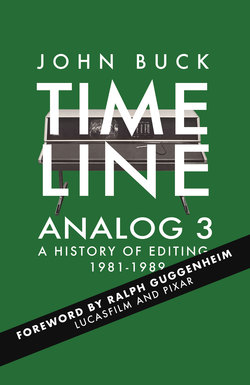Читать книгу Timeline Analog 3 - John Buck - Страница 22
На сайте Литреса книга снята с продажи.
HESTER AND IVES
ОглавлениеDespite the growing advances in video hardware, most editing was still carried out in the analog domain on turn key systems. Jerry Hester had completed EECO's new timecode based editing system, the Intelligent Video Editing System (IVES).
Having been built from scratch to exploit three microprocessors, the IVES (above) differed from many of its competitors because it was 'absolutely frame accurate' and used a new generation user interface.
IVES integrated into the edit controller the timecode reader/generators and all of the common timecode functions that needed to be performed prior to editing. It had special "macro keys" which, after being hit three times, initiated processes like making a B roll copy of rushes on an available VTR, with or without the same timecode.
I attempted to simplify all of the separate operations that drove people mad in edit bays when preparing tapes for an editing session using timecode. Operations like setting up the timecode generator and connecting everything correctly, selecting the channel to record timecode on, rewinding the tapes, placing the deck into record mode and starting the generator, etc.
"Striping" blank tapes with black and timecode and adding timecode to source tapes were the two most common timecode functions performed prior to editing using timecode. With IVES, you could simply push one button and it would take over to rewind a blank tape, play it from the head, back-time the timecode generator and then go into record mode and begin striping it with black and timecode. While this was happening, you could then add a different timecode to a source tape.
Other "Macro" timecode functions included adding timecode to a source tape while also making a copy with the same timecode and adding different timecodes to two tapes at the same time. No use wasting time. All of these timecode functions were possible because IVES contained two independent timecode reader/generators and built in A/V routing systems.
But they were hidden away from the editor. After all, the people editing just wanted to edit, not get caught up with the technical aspect of preparing the tapes for editing, or dealing with color framing, timecode and syncing issues.
For actual editing tasks. the IVES had a rotary knob with a centre detent like that found on a Sony VO-5850. The knob was mounted on a horizontal slide which allowed it to move it left or right and in turn select the Source or Record deck for control. In addition, the knob could be pushed down to initiate an Edit Preview. Other features included a built in black burst generator, programmable A/V facer and mic/line mixer.
But most importantly what IVES didn't have was or need any adjustments to tweak in order to repeatedly perform frame accurate editing. It just worked time after time after time.
Hester had only just returned to California after the launch of IVES at NAB when he took a call from a headhunter acting for Convergence Corporation.
I was flattered that Convergence wanted to hire me and I ended up at Convergence's corporate offices getting a big sales pitch from Julian Hanson and George Bates. But I think what Convergence was really up to was to simply get me to leave EECO, because if I left EECO, so too would have most of the ideas and enthusiasm for the IVES and that could have ended or stalled its continued development.
